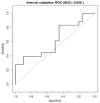Predicting Radiotherapy Impact on Late Bladder Toxicity in Prostate Cancer Patients: An Observational Study
- PMID: 33419144
- PMCID: PMC7825573
- DOI: 10.3390/cancers13020175
Predicting Radiotherapy Impact on Late Bladder Toxicity in Prostate Cancer Patients: An Observational Study
Abstract
Background and purpose: The aim of our study was to elaborate a suitable model on bladder late toxicity in prostate cancer (PC) patients treated by radiotherapy with volumetric technique.
Materials and methods: PC patients treated between September 2010 and April 2017 were included in the analysis. An observational study was performed collecting late toxicity data of any grade, according to RTOG and CTCAE 4.03 scales, cumulative dose volumes histograms were exported for each patient. Vdose, the value of dose to a specific volume of organ at risk (OAR), impact was analyzed through the Mann-Whitney rank-sum test. Logistic regression was used as the final model. The model performance was estimated by taking 1000 samples with replacement from the original dataset and calculating the AUC average. In addition, the calibration plot (Hosmer-Lemeshow goodness-of-fit test) was used to evaluate the performance of internal validation. RStudio Software version 3.3.1 and an in house developed software package "Moddicom" were used.
Results: Data from 175 patients were collected. The median follow-up was 39 months (min-max 3.00-113.00). We performed Mann-Whitney rank-sum test with continuity correction in the subset of patients with late bladder toxicity grade ≥ 2: a statistically significant p-value with a Vdose of 51.43 Gy by applying a logistic regression model (coefficient 4.3, p value 0.025) for the prediction of the development of late G ≥ 2 GU toxicity was observed. The performance for the model's internal validation was evaluated, with an AUC equal to 0.626. Accuracy was estimated through the elaboration of a calibration plot.
Conclusions: Our preliminary results could help to optimize treatment planning procedures and customize treatments.
Keywords: decision supporting systems; predictive models; prostate cancer; toxicity prediction.
Conflict of interest statement
No actual or potential conflict of interest exist regarding this article.
Figures






Similar articles
-
Tolerance doses for late adverse events after hypofractionated radiotherapy for prostate cancer on trial NRG Oncology/RTOG 0415.Radiother Oncol. 2019 Jun;135:19-24. doi: 10.1016/j.radonc.2019.02.014. Epub 2019 Mar 5. Radiother Oncol. 2019. PMID: 31015166 Free PMC article.
-
Preliminary report of toxicity following 3D radiation therapy for prostate cancer on 3DOG/RTOG 9406.Int J Radiat Oncol Biol Phys. 2000 Jan 15;46(2):391-402. doi: 10.1016/s0360-3016(99)00443-5. Int J Radiat Oncol Biol Phys. 2000. PMID: 10661346 Clinical Trial.
-
Acute and late complications after radiotherapy for prostate cancer: results of a multicenter randomized trial comparing 68 Gy to 78 Gy.Int J Radiat Oncol Biol Phys. 2005 Mar 15;61(4):1019-34. doi: 10.1016/j.ijrobp.2004.07.715. Int J Radiat Oncol Biol Phys. 2005. PMID: 15752881 Clinical Trial.
-
Predictors for late genitourinary toxicity in men receiving radiotherapy for high-risk prostate cancer using planned and accumulated dose.Phys Imaging Radiat Oncol. 2023 Feb 2;25:100421. doi: 10.1016/j.phro.2023.100421. eCollection 2023 Jan. Phys Imaging Radiat Oncol. 2023. PMID: 36817981 Free PMC article.
-
Dose-volume analysis of predictors for chronic rectal toxicity after treatment of prostate cancer with adaptive image-guided radiotherapy.Int J Radiat Oncol Biol Phys. 2005 Aug 1;62(5):1297-308. doi: 10.1016/j.ijrobp.2004.12.052. Int J Radiat Oncol Biol Phys. 2005. PMID: 16029785 Review.
Cited by
-
Dose-volume analysis of planned versus accumulated dose as a predictor for late gastrointestinal toxicity in men receiving radiotherapy for high-risk prostate cancer.Phys Imaging Radiat Oncol. 2022 Jul 16;23:97-102. doi: 10.1016/j.phro.2022.07.001. eCollection 2022 Jul. Phys Imaging Radiat Oncol. 2022. PMID: 35879938 Free PMC article.
-
Covid-19 and radiotherapy: a systematic review after 2 years of pandemic.Clin Transl Imaging. 2022;10(6):611-630. doi: 10.1007/s40336-022-00513-9. Epub 2022 Jul 23. Clin Transl Imaging. 2022. PMID: 35910079 Free PMC article. Review.
-
Rectum and Bladder Toxicity in Postoperative Prostate Bed Irradiation: Dose-Volume Parameters Analysis.Cancers (Basel). 2023 Nov 9;15(22):5334. doi: 10.3390/cancers15225334. Cancers (Basel). 2023. PMID: 38001594 Free PMC article.
-
Feature Importance Analysis of a Deep Learning Model for Predicting Late Bladder Toxicity Occurrence in Uterine Cervical Cancer Patients.Cancers (Basel). 2023 Jul 2;15(13):3463. doi: 10.3390/cancers15133463. Cancers (Basel). 2023. PMID: 37444573 Free PMC article.
-
Predictive modelling for late rectal and urinary toxicities after prostate radiotherapy using planned and delivered dose.Front Oncol. 2022 Dec 16;12:1084311. doi: 10.3389/fonc.2022.1084311. eCollection 2022. Front Oncol. 2022. PMID: 36591496 Free PMC article.
References
-
- Arnold M., Karim-Kos H.E., Coebergh J.W., Byrnes G., Antilla A., Ferlay J., Renehan A.G., Forman D., Soerjomataram I. Recent trends in incidence of five common cancers in 26 European countries since 1988: Analysis of the European Cancer Observatory. Eur. J. Cancer. 2015;51:1164–1187. doi: 10.1016/j.ejca.2013.09.002. - DOI - PubMed
-
- National Comprehensive Cancer Network (NCCN) NCCN Clinical Practice Guidelines in Oncology. Prostate Cancer. Version 2. [(accessed on 27 November 2017)];2020 Available online: https://www.nccn.org/professionals/physician_gls/default.aspx#site.
LinkOut - more resources
Full Text Sources
Other Literature Sources
Miscellaneous

